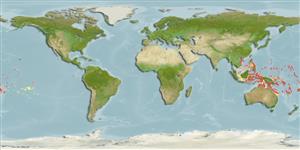>
Gobiiformes (Gobies) >
Gobiidae (Gobies) > Gobiinae
Etymology: Istigobius: Greek, istios = sail + Latin, gobius = gudgeon (Ref. 45335).
More on author: Herre.
Environment: milieu / climate zone / Tiefenbereich / distribution range
Ökologie
seewasser riff-verbunden; tiefenbereich 0 - 30 m (Ref. 1602). Tropical; 20°N - 25°S
Western Pacific: Philippines and Indonesia to Kiribati and Fiji, south to Rowley Shoals in the eastern Indian Ocean and the Great Barrier Reef. Reported from the Ryukyu Islands (Ref. 559).
Size / Gewicht / Alter
Geschlechtsreife: Lm ? range ? - ? cm
Max length : 10.8 cm TL Männchen/unbestimmt; (Ref. 11344)
Rückenflossenstacheln (insgesamt) : 7; Rückenflossenweichstrahlen (insgesamt) : 10 - 11; Afterflossenstacheln: 1; Afterflossenweichstrahlen: 9 - 10; Wirbelzahl: 26. Upper pectoral fin rays entire. Predorsal with 7-9 cycloid scales; trunk with ctenoid scales. Segmented and non branching caudal rays 4, branching 13. Body color yellowish white; 2 brown diagonal lines from preoperculum to upper jaw, connected by a single line; 2 almost vertical brown lines on operculum. 4th spine of 1st dorsal fin longest. No sharp distinction between sexes in pigmentation and elongation of 2nd dorsal, pelvic and anal fins. Males sometimes with 3-4 dusky vertical bars on abdomen (Ref. 420); fully united pelvic fins with well-developed frenum; longitudinal scale series 29-32; predorsal scales 7-9, reaching interorbital space; absence of scales on cheek or opercle; depth of body 4.7-6.1 in SL (Ref. 90102).
Body shape (shape guide): elongated; Cross section: circular.
Solitary (Ref. 90102). Occurs in sandy areas with living corals and coral rubble in clear waters, Ref. 48637.
Life cycle and mating behavior
Geschlechtsreife | Fortpflanzung | Ablaichen | Eier | Fecundity | Larven
Genital papilla of male terminating to side of anal spine. Papilla of female truncate and terminating posteriorly well before origin of anal fin.
Murdy, E.O. and D.F. Hoese, 1985. Revision of the gobiid fish genus Istigobius. Indo-Pac. Fish. (4):41 p. (Ref. 420)
IUCN Rote Liste Status (Ref. 130435: Version 2025-1)
Bedrohung für Menschen
Harmless
Nutzung durch Menschen
Tools
Zusatzinformationen
Download XML
Internet Quellen
Estimates based on models
Preferred temperature (Ref.
123201): 25.5 - 29.3, mean 28.6 °C (based on 1556 cells).
Phylogenetic diversity index (Ref.
82804): PD
50 = 0.5005 [Uniqueness, from 0.5 = low to 2.0 = high].
Bayesian length-weight: a=0.00724 (0.00339 - 0.01546), b=3.10 (2.92 - 3.28), in cm total length, based on LWR estimates for this (Sub)family-body shape (Ref.
93245).
Trophic level (Ref.
69278): 3.3 ±0.4 se; based on size and trophs of closest relatives
Widerstandsfähigkeit (Ref.
120179): hoch, Verdopplung der Population dauert weniger als 15 Monate. (Preliminary K or Fecundity.).
Fishing Vulnerability (Ref.
59153): Low vulnerability (10 of 100).
🛈
Nutrients (Ref.
124155): Calcium = 130 [59, 246] mg/100g; Iron = 0.752 [0.389, 1.441] mg/100g; Protein = 17.9 [16.0, 19.7] %; Omega3 = 0.0927 [, ] g/100g; Selenium = 25.7 [12.3, 56.5] μg/100g; VitaminA = 120 [32, 410] μg/100g; Zinc = 1.97 [1.28, 2.90] mg/100g (wet weight);
